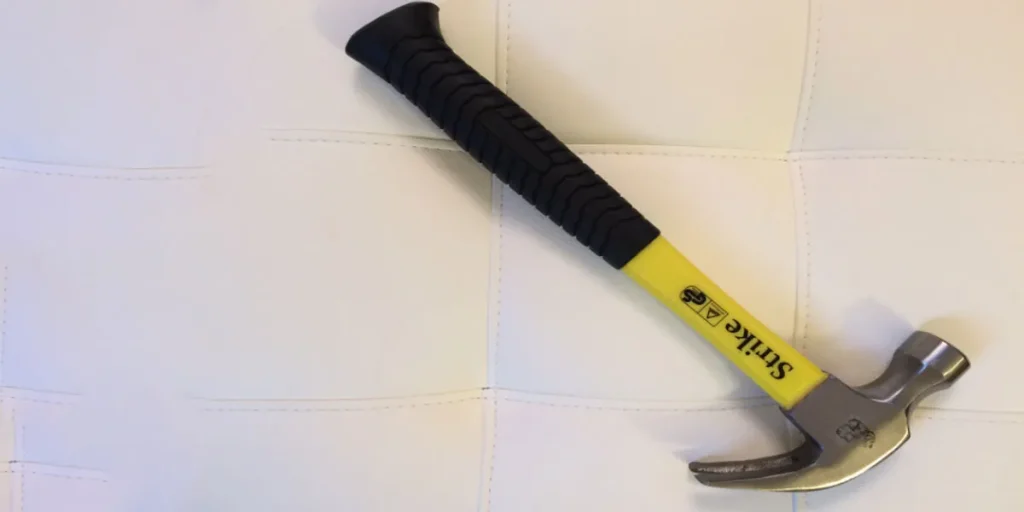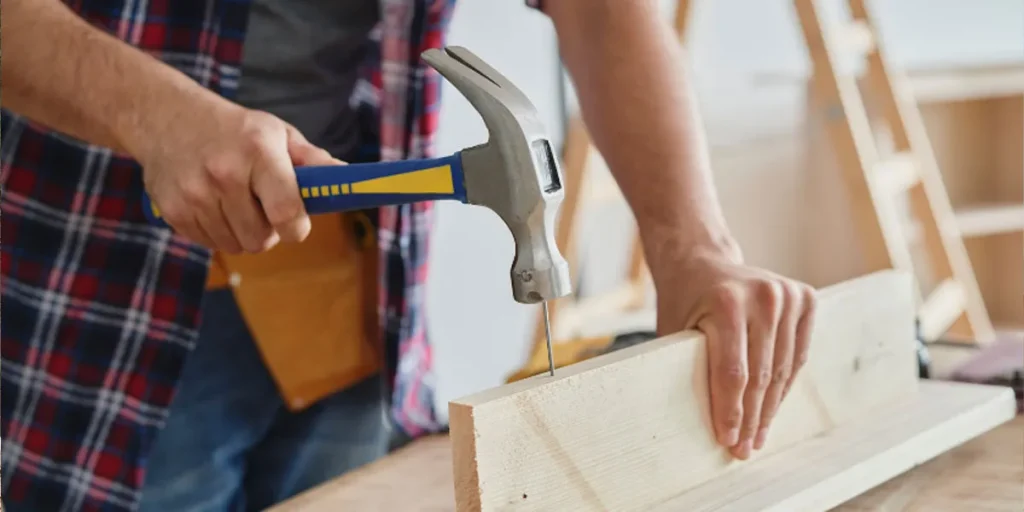A typical claw hammer weighs about 16 to 20 ounces. Sledgehammers can range from 4 to 20 pounds, depending on their use.
Hammers are fundamental tools in various industries, ranging from construction to metalworking.
Their weight varies as it corresponds to their specific purposes and design features, designed to balance effectiveness and user fatigue.
A standard household hammer is lighter, facilitating easy handling for everyday tasks like driving nails or breaking objects.
For more heavy-duty applications, such as demolition or driving spikes, a heavier sledgehammer is more appropriate.
When selecting a hammer, consider the weight that will best suit the intended tasks, ensuring efficiency and safety.
The variety of hammer weights responds to the needs of both professional tradespeople and DIY enthusiasts, each seeking the right tool for their project.
Why Hammer Weight Matters?
Choosing the right hammer is not just about the grip or the material. The weight of a hammer plays a crucial role in how effectively it can be used for various tasks.
Whether you’re a seasoned professional or a weekend DIY enthusiast, understanding why hammer weight matters will lead to better workmanship, less fatigue, and increased safety.
Balance Between Control And Force
The right balance between control and force is essential for precision and power in hammering.
A hammer too light may not deliver enough force, while one too heavy can be unwieldy.
- Lighter hammers (<1lb) are best for delicate tasks where precision is key.
- Medium-weight hammers (1-2lbs) offer a good mix for general purposes.
- Heavier hammers (>2lbs) maximize force, ideal for demolition jobs.
Impact On Fatigue And Efficiency
The weight of a hammer directly impacts user fatigue and work efficiency. A well-chosen hammer weight reduces strain and boosts productivity.
| Hammer Weight | Fatigue Level | Efficiency |
|---|---|---|
| Light | Lower Fatigue | High Precision |
| Medium | Moderate Fatigue | Good Balance |
| Heavy | Increased Fatigue | High Force |
Longer durations with an incorrectly weighted hammer can lead to early exhaustion and even injury. In contrast, the right hammer makes the job easier and allows for longer work without tiring.
Common Types Of Hammers And Their Weights

When tackling a project, choosing the right hammer is key. Each type has a specific weight and purpose.
Understanding the common types and their weights can make any task easier. Let’s take a closer look.
Claw Hammers: The Diy Staple
The claw hammer is the most common tool in a DIY kit. Its design is perfect for driving nails into wood and removing them. Claw hammers come in various weights, suitable for different tasks.
- Light-Duty: 8 to 10 ounces for small indoor tasks
- Medium-Duty: 16 ounces for general carpentry
- Heavy-Duty: 20 ounces for framing and construction
Sledgehammers: Heavier For Demolition
A sledgehammer is a heavy-duty tool designed for serious impact. It breaks through concrete and drives stakes with ease. It’s an essential for demolition work.
| Size | Weight Range | Common Uses |
|---|---|---|
| Small | 2 to 4 pounds | Home projects |
| Medium | 6 to 8 pounds | Framing, garden work |
| Large | 10 to 20 pounds | Building demolition |
Factors Influencing A Hammer’s Weight
When selecting the right hammer for a job, its weight plays a crucial role. Different tasks require hammers of varying weights.
Understand the factors affecting a hammer’s weight to make an informed choice.
Material Composition
The material of the hammer head influences its weight significantly. Typically, hammer heads are made of materials like:
-
- Steel: Heavy and durable, suits heavy-duty tasks.
- High-carbon steel: Heavier than stainless steel, used for professional grade tools.
- Titanium: Lightweight yet strong, ideal for reduced fatigue during long use.
Different materials cater to specific needs:
| Material | Weight Class | Common Use |
|---|---|---|
| Steel | Heavy | Construction |
| High-carbon Steel | Very Heavy | Demolition |
| Titanium | Lightweight | Finish Work |
Handle Length And Design
The handle is a key factor in a hammer’s overall weight. Long handles provide more leverage but increase weight. Designs like:
-
-
- Straight handles: Simple and often lighter.
- Curved handles: Ergonomic, may add slight weight.
-
Handles come in different materials:
-
- Wood: Traditional, can vary in weight based on the type of wood.
- Fiberglass: Durable and moderate in weight.
- Steel: Can be heavy, often paired with a rubber grip for comfort.
Choosing The Right Hammer For Your Project

When starting a project, the weight of your hammer matters. A hammer too heavy might tire you out.
One too light may not get the job done. Let’s dive into how to pick the best hammer for the task ahead.
Consider The Task At Hand
Different jobs need different hammers. Here’s a quick overview:
- Small tasks: A lightweight tack hammer works well.
- Drywall: Choose a hammer with a rounded finish.
- Framing: A heavier framing hammer is ideal.
Select one that suits your project needs for the best results.
Personal Comfort And Strength
Your physical ability plays a role in the right hammer choice.
- Easy handling: Pick a hammer that feels good in your hand.
- Consider weight: A hammer too heavy can cause strain.
- Test before buying: A quick trial run in the store helps.
Matching the hammer to your personal strength ensures comfort and efficiency.
Safety And Ergonomics
Safety and ergonomics play crucial roles in handling hammers. A hammer’s weight affects its use. A hammer too heavy can tire a user quickly.
A hammer too light may need extra force to work. Both cases can lead to injuries. Proper techniques and awareness of ergonomics can prevent pain and accidents.
Proper Handling Techniques
Holding and using a hammer correctly ensures safety and efficiency. Keep these points in mind:
- Choose the right hammer for the job.
- Grip the handle near the end for maximum leverage.
- Stand firm and balanced.
- Swing from the elbow and shoulder, not just the wrist.
- Strike the surface squarely with the hammer’s face.
Avoiding Repetitive Strain Injuries
Repetitive motions can harm. To avoid repetitive strain injuries:
- Take breaks between tasks.
- Do stretching exercises for your hands and arms.
- Use ergonomic hammers with shock-absorbing features.
- Alternate tasks to vary movements.
- Keep wrist straight to reduce strain.
Maintenance And Care For Longevity
Ensuring a hammer lasts for years involves regular maintenance and proper care. Like any other tool, hammers require attention to maintain their effectiveness and safety.
By following some simple maintenance routines, you can protect your investment and make sure the hammer is ready for any job.
Cleaning And Storage Tips
Keeping a hammer clean and properly stored is crucial for its longevity. Here’s how to do it:
- Wipe down the hammer after each use to remove dirt and debris.
- Use a mild detergent for sticky or greasy residue.
- Dry completely to prevent rusting of the metal parts.
- Oil the handle if it’s made of wood to keep it from drying out.
- Store in a dry place away from the elements.
- Hang or place the hammer in a tool organizer to avoid damage.
Regular Inspection For Wear And Damage
Hammers should be checked regularly to ensure they’re safe to use. Here are key inspection pointers:
- Look for cracks or splinters in the handle.
- Ensure the head is firmly attached to the handle.
- Check for any wear or damage on the hammer’s striking surfaces.
- Replace the hammer if you notice significant wear or damage.
Regular inspection and prompt action when issues are found will extend the life of your hammer and make your tasks safer.
FAQs About the Weight of a Hammer
What Is The Average Weight Of A Hammer?
A typical claw hammer, used for general carpentry, weighs about 16 ounces.
However, lighter versions of 10 ounces are available for smaller tasks, and heavier ones, up to 32 ounces, are used for more demanding projects like framing.
Do Different Hammer Types Vary In Weight?
Yes, hammer weights vary significantly across types.
For instance, a sledgehammer can weigh between 4 to 14 pounds, while a tack hammer might weigh as little as 4 ounces.
The weight is designed to match the specific function and use of each hammer type.
How Does Hammer Weight Impact Usage?
The weight of a hammer affects usage by determining the force it can apply and the control one has.
Heavier hammers are better for driving nails into hard materials, but require more strength and can cause fatigue.
Lighter hammers offer precision and ease of handling for detailed work.
Can Hammer Weight Influence Project Outcome?
Absolutely. Choosing the right hammer weight can greatly affect the quality and efficiency of your work.
A heavier hammer might be faster for driving large nails, but a lighter one might reduce the risk of damaging delicate materials or causing user fatigue.
Conclusion
Understanding the weight of a hammer is crucial for both DIY enthusiasts and professional builders.
The average hammer weight varies, typically falling between 7 ounces to 32 ounces. Selecting the right one maximizes efficiency and safety.
Keep in mind your project needs when choosing, ensuring a successful, comfortable work experience.
Remember, the right hammer makes all the difference.
